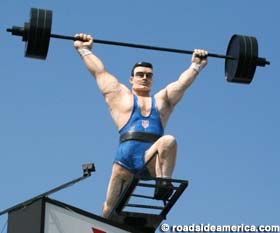
Hundreds of thousands of drivers on Interstate 83 have seen the famous larger-than-life revolving statue of an unknown weightlifter holding an even larger barbell above his head. The statue sits on top of the York Barbell Company. The weightlifter watches every car, begging the driver to stop and stare, perhaps even challenge him in a competition. For years now, the builder has been a symbol of Bob Hoffman's empire that started three-quarters of a century ago.
The statue is actually modeled after Norbert Schemansky, an Olympic weightlifter, said Michael Locondro, York Barbell Company manager. The statue is modeled after Schemansky's body but not his face, he added. "We call him The Barbell Guy. Not Norbert or Norm," Locondro said laughing.
In the early 1900s, weightlifting was regarded as a circus act, something so out-of-the-ordinary that it was not a respectable Olympic event until one man, Bob Hoffman, revolutionized the sport, opening the door for today's superstars.
Bob Hoffman was born on November 9, 1898, in Tifton, Georgia to Addison and Bertha Hoffman. Bertha was a delicate woman while Addison was a large man who loved to flex his pecs in public and watch others stare at his bulging biceps. On the contrary, as a young boy, Bob was small and sickly. He had typhoid fever when he was 10 years old that left him weak. His great interest in sports, especially aquatics, helped him build physical strength. His natural flair for canoeing won him many titles and front page articles in the Pittsburgh Post Gazette. He was also very smart and skipped a grade; however, he never went to college, opting to join the armed forces instead.
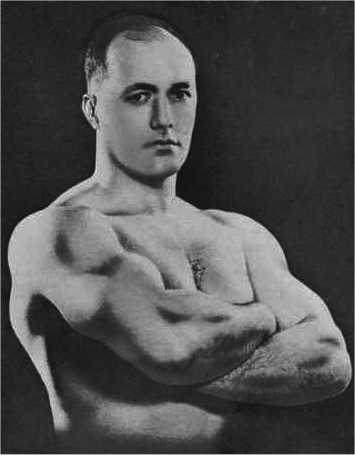
Hoffman had a tendency to exaggerate the truth, a habit he developed as a young boy and carried over into adulthood. John D. Fair wrote in his book, Muscletown USA: Bob Hoffman and the Manly Culture of York Barbell about an instance when Hoffman was nine years old. A 10- mile race was held, in which young Hoffman wanted to compete. However, Hoffman's father said no. Hoffman said at the beginning of the race some of the contestants gave him their clothes to hold while they ran in their athletic gear. Hoffman, knowing they would eventually need their clothing back, ran with them. He said, "At the end of the ten miles, I was running beside the winner carrying the clothes and shoes, fresh as I could be and it would have been easy to win had I been properly entered." It seems far-fetched for his account to be accurate, but Hoffman's ability to stretch the truth was not uncommon. An associate once said about Hoffman, "Myth assumed an inspirational quality that truth could never attain." Hoffman's larger-than-life half-truths catapulted him to the forefront of the weightlifting world.
In 1920, Hoffman moved to York, Pennsylvania to be closer to his brother and his family. He formed a partnership with Ed Kraber and started selling oil burners and formed York Oil Burner Athletic Club, later named York Barbell Company. Then in 1928, he started courting Rosetta Snell, a teenager who already had a child from a previous marriage, and whose 14 brothers and sisters called Hoffman "Daddy Bob." The couple married on October 20.
In 1932, Hoffman stopped making oil burners and switched to barbells instead, using the same employees, many of whom later became champion body builders. Offering incentive to his employees, Hoffman provided $10 a week at the plant, training facilities, travel stipend for competitions, a gold medal for those who broke an American record and a diamond studded gold medal for those breaking world records, ExplorePAHistory.com reported. Hoffman trained the US team for the 1932 Olympics in Los Angeles. The medals helped change the perception of many people who had until that point regarded it as a "carnival sideshow." Then, in 1946, when America won its first world team championship, four of the six lifters worked for Hoffman. By that time, his celebrity was beginning to rise and with it, his ego. His ego grew even larger in 1936 when he coached Tony Terlazzo in the Berlin Olympics. Terlazzo won the first gold medal in the sport.
By the mid-30's young men were making pilgrimages to York in droves. Fair writes, "For young men who wanted to become stronger and healthier, York was for decades a Mecca, where Hoffman served as their prophet..." Many stars from the York Gang made the pilgrimage. During the 30s and 40s, Hoffman created the York Gang, later referred to as the Old York Gang. The York Gang was comprised of ethnic immigrants who had everything to gain and nothing to lose from weightlifting world. It was said to be the, "pantheon of iron-game heroes." Hoffman had a liked to train young men who had either a personal or physical disability. He saw himself in those young men, and found that they worked harder, wanting to overcome the odds. Hoffman trained them to become champions producing the likes of John Terpak and John Grimek, Fair wrote.
From 1945 to 1960, York's fame skyrocketed, giving York the nickname "Muscletown U.S.A." During the height of his success, Hoffman coached the US weightlifting team from 1936-1968. York Barbell became one of three companies in the world certified to make weights for the Olympics, manufacturing them for the 1952, 1968 and 1984 games, the company's website stated. Locondro said that the company does not have plans to produce and supply weights for future Olympic Games.
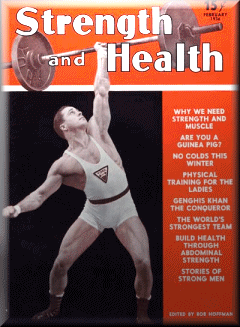
To complement his growing celebrity, Hoffman added muscle-building supplements to the company. One popular supplement was Hi-Proteen, a soy-powder he used in shakes. Hi-proteen was also one of the first commercially available muscle supplements. Originally, he was against using supplements to produce champions, but then found with supplements "muscles are being built at a pace never before attained" and he was hooked. The company no longer produces supplements. In 1932, he also started the magazine Strength and Health for men. The magazine was comprised naturally with articles about how to build muscle as well as articles by Hoffman himself. Many of his articles were sexual in nature, stating that physical strength directly correlated to sexual stamina. Then, in 1964, he started another magazine Muscular Development. Both magazines stopped publication in 1986 and 1989 respectively. The rights to Muscular Development have since been sold and Strength and Health was revived in 2001 as an online publication. It is not a monthly publication though, said Locondro.
Steroids were not connected to athletics until the weightlifters in York started to use them. John Ziegler, a man who practiced medicine as well as a fitness lover, befriended many body builders associated with York Barbell Co., wrote Justin Peters in the article "The Man Behind the Justice." Ziegler eventually traveled with the team to the 1954 World Weightlifting Championships in Vienna, where he was astounded by the Russians' strength. Over drinks, the Russian team's doctor said the team built muscle with shots of testosterone. Upon their return to the United States, Dr. Ziegler administered the shots to the York Team. Then in 1958, Ciba Pharmaceuticals marketed his drug Diananbol. At the time, it was used mainly for the elderly and burn victims but body builders also used it. Dr. Ziegler only prescribed small doses to his fitness clients, but the results were so dramatic that the pill was abused. Hoffman contributed the muscle gain to his a new training regimen called isometric contraction, but the true reason eventually came out, Peters wrote. Athletes clamored to get their hands on the steroids. Dr. Ziegler was horrified by some of the results of steroid use such as enlarged prostates and atrophied testes, Peters wrote. Before his death, Dr. Ziegler came out against Diananbol writing in the introduction to Bob Goldman's book, Death in the Locker Room, "It is bad enough to have to deal with drug addicts, but now healthy athletes are putting themselves in the same category. It's a disgrace. Who plays sports for fun anymore?"
The "New" York Gang had formed by this point, and they were no longer uneducated first generation young men, but rather held college degrees and knew the science behind building muscle. They regarded Hoffman as more of a grandfather figure than a deity on Earth, as others previously had. He and his wife, Rosetta, began drifting apart and separated as well. Hoffman quickly moved on to other women such as Gracie Bard, a regular fixture at the magazine. He then dated Dorcas Lehman and then finally Alda Ketterman.
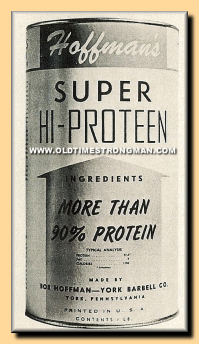
Fame eventually hits its peak before coming down. In the 1960s, Hoffman's teams started to lose. Then reports came of customers who were unsatisfied with the products, Fair said. There were reports that Hi-Proteen powder poured into the Super Hi-Proteen powder bottles. Also, various people panned his supplements stating that the written percentage of iron, calcium, and other essential nutrients were incorrect.
By the 1960's, the frenzy surrounding York, Bob Hoffman, and the York Barbell Co. had subsided. There were setbacks along the way, but they did not deter from company accomplishments. "York's position is an enviable one. Its customers number virtually all the professional football teams, including the Jets and the Giants, and countless high school and college gyms," Peter Durantine wrote in the Sacramento Bee. Locondro said that the company supplies to "anybody that lifts weights." People have said that the company is currently struggling with people moving away from barbells to nautilus equipment but Locondro contests that is not true, rather that there is a countermovement back toward strength training.
In the 1970s there was a surge in sales partly due to Hoffman's philanthropic efforts through the Hoffman Foundation, Fair wrote. Hoffman realized that he could gain even more fame and fortune through the foundation. After Hoffman met President Nixon, he claimed that the president used his barbells to train. Although the possibility of President Nixon using his barbells and telling Hoffman he did so is highly unlikely, it was Hoffman's ability to persuade others to think so that launched him as a national figure. His connection to the presidents is undeniable. Locondro said Hoffman served as an advisor to Eisenhower, Kennedy, and Nixon. Hoffman gave thousands of dollars to the Dover and York YMCAs. He founded Nixon Park in York County. His foundation today profits about $1.2 million, Locondro said. He said that many organizations send in letters and petitions and the Foundation decides whether, for example, the YMCA needs another Treadmill or a middle school with no athletic program should have athletic equipment.
As a national icon, Hoffman blurred the line between business man, political ally, and philanthropist Fair wrote, "Increasingly he sought escape to a higher ground of general fitness, national politics, and philanthropy, where he could indulge in myths that would obscure reality and transform failure into success." This enabled him, Fair wrote, to appear on the Today Show and the Mike Douglas Show as well to be featured in Reader's Digest. Over the course of his life, he published 70, mainly self-help, books.
Right next to the York Barbell Co. building is the USA Weightlifting Hall of Fame. Going back to ancient Greek origins, the museum pays special attention the growth of the sport through the centuries. The museum honors all the weightlifting greats that Hoffman coached to the top of the sport. The museum pays equal attention to the women weightlifters. It has biographies of the stars, barbells through the ages, trophies and much more.
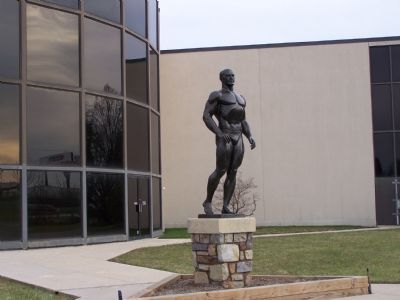
Nowadays the "The Barbell Guy" sits on the top of York Barbell reminding onlookers of the glory days. The fame that Hoffman brought to York County and the York Barbell Co. are undeniable. During Hoffman's last few years, he came face-to-face with reality. "As Bob approached his eightieth birthday, he lost his drive—mental, physical, and sexual—and ultimately his purpose in life. No longer able to uphold the body of manly myths he had created around himself since the early years of the century, Hoffman was at last faced with the reality of his own morality," Fair wrote. At the same time, sales at the company slowed. Bob Hoffman died on July 18, 1985 in York, due to heart disease.
The national attention that the company used to garner has diminished. The company has no current plans of manufacturing weights for the Olympics. It no longer publishes national weightlifting magazines either. "Currently we are trying to re-grow the company and strengthen it," Locondro said. However, how exactly they plan to do that is not precisely known. The constant need for celebrity that Hoffman had seems to have declined with his death. Irrefutably a significant contributor to the weightlifting world, the company seems to shy away from being in the spotlight. The Bob Hoffman Foundation has recently been given center stage, putting emphasis on the need for physical education in the local community.
Sources:
- "Bob Hoffman." Historical Markers. 2003. Explore PA History. 22 July 2008 < http://www.explorepahistory.com/hmarker.php?markerId=991>.
- "Bob Hoffman: Timeline." York Barbell Co. 2003. The York Barbell Company. 26 July 2008
- Durantine, Peter. "York Barbell Trying to Lift Sagging Image." The Sacramento Bee Mar. 1998: F2.
- Fair, John D. Muscletown USA: Bob Hoffman and the Manly Culture of York Barbell. University Park, PA: The Pennsylvania State University Press, 1999.
- Fillary, Roger. "Bob Hoffman." Sandow and the Golden Age of Iron Men. July 2008. < http://www.sandowplus.co.uk/Competition/Hoffman/hoffmanindex.htm>.
- Goldwasser, Thomas. "Pumping Iron, Not Concrete." The New York Times 21 Sep. 1986: A4.
- Locondro, Michael. Personal interview. 2008.
- McClain, Buzz. "Muscling to the Mass Market; York Barbell, Maker of Major Weight Lifting Gear, Wants To Sell Health-Enhancing Products to the Rest of Us." The Washington Post 5 Aug. 2003: F1.
- Peters, Justin. "The Man Behind the Juice." Slate. 18 Feb. 2005. Sports Nut: Stadium Scene. 22 July 2008 < http://www.slate.com/id/2113752/>.
- "The #1 Blog for Old Time Strongman Training and Physical Culture." Oldtimestrongman.com. 2008. John Wood and Thunderdome Media. 20 July 2008<http://www.oldtimestrongman.com/blogs/new-blog>.
Photo credits include oldtimestrongman.com, and the Historic Marker Database.
